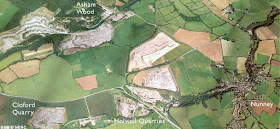One of the Holwell Quarry faces. I think I might accept that this is a quarry, since it has a number of features which look just like those of Pembrokeshire working and recent quarries!
The quarries to the west of Nunney
Tony has been alerting is occasionally to strange things happening near Nunney -- nothing to do with my grandsons, I hope.......... but are there any glacial or other Pleistocene deposits here?
Previous posts:
http://brian-mountainman.blogspot.co.uk/2011/01/prudden-on-holwell.html
http://brian-mountainman.blogspot.co.uk/2011/01/something-strange-at-nunney.html
And this is what Hugh Prudden has to say -- he is clearly of the view that the sediments are Triassic - Jurassic residues which have found their way into fissures. But Kellaway talks somewhere of an actual layer around a metre thick, resting on the rock surface.
from
SOMERSET GEOLOGY - A GOOD ROCK GUIDE
Hugh Prudden
23. HOLWELL ST 7245 5 km S W of Frome Fissures with Triassic and Jurassic infills-tectonics
There are old quarry workings down a track to the right of the pub (ST 729 452). A large multi-stage fissure runs the length of an old quarry wall at the eastern end of quarry used as a car park. Part of the fill has collapsed enabling Triassic, Rhaetian and Jurassic sediments plus the mineralisation to be examined at close quarters. The sediments appear to have entered the fissures in both a lithified and partly lithified state. Deformation of the sediments seems to have been associated with the opening of the fissure and the intrusion of the sediments. There are footpaths to the nearby village of Nunney which has a nice pub, castle ruins (Doulting and Bath Stone) and sarsen stones (Tertiary silcretes) on a wall and near castle at the bottom of the hill leading from Nunney Catch.
Park in lay-by to the east of the Bear Inn. Please first contact Mr R Bullus of Valley Sawmills, Holwell, Nunney, Frome for permission to visit the site.
A viewing platform has been built overlooking Colemans large quarry on the north side of the workings. Park in lay-by at sharp corner on the road the Whatley at ST 7231 4529 and walk some 200 m NNW along footpath. There is a fascinating view both of the quarry activity and the undulations of the same unconformity as seen at Tedbury Camp quarry. In addition the view includes the overlying Jurassic and Cretaceous terrains to the east. There are few better places where one can appreciate geological time and space.
More:
SSSI citation:
Description and Reasons for Notification: Holwell Quarries represent an internationally important geological locality. A comprehensive assemblage of Triassic (including Rhaetic), Lower Jurassic and Middle Jurassic fissure fillings are well displayed. The Rhaetic fissure fillings have yielded the richest assemblage of vertebrate faunas known from the British Triassic. The site is famous as the site where Moore (in the 1860s), and later Kuhne (1939), collected specimens of Rhaetic mammals; occurrences of the highest scientific interest. Other mammals as well as abundant fish remains from the site have yet to be described. Fissure deposits have also yielded 8 or 9 genera of Reptiles: a Crocodilian, a Placodont (the first record in Britain of this sub-order), and the dinosaurs Thecodontosaurus and Palaeosaurus. The Lower Jurassic fissure fillings yield ammonites and brachiopods which are important in dating these remarkable deposits. Subsidiary interest is supplied by the three dimensional 'wadi-fill' of Triassic age and the regionally important sub-Inferior Oolite unconformity, both of which are very well exposed in the Holwell complex.
Some of the exposed features -- the most famous of which is the unconformity.
This is a large and complex series of quarries, and one would not know where to start in looking for undisturbed superficial deposits. Does anybody know these quarries? If so, any pointers?




These karstic fissure deposits with vertebrate remains are 'common' and widespread some in south Wales.
ReplyDeleteM
Yes, they are common in South Pembs all around the limestone coast. Much debate about the "gash breccias" - I know them well. But they are very different from the pipeclays and other enigmatic deposits -- such as the strange "Oligocene" deposit near Flimston, sitting in a hollow on the limestone surface.
ReplyDelete